

Becky
Artist & Knitter
ColourMart Shop for Cashmere Yarn, Aran and Lace. Yarn - Weaving Supplies - Looms - Lunatic Fringe Yarns. On Yarn Weights and Counts. Many of our customers have told us that they do not understand what quoted thicknesses of 2/18, 3/8, etc. actually mean.
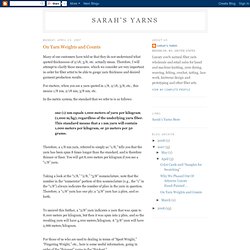
Therefore, I will attempt to clarify these measures, which we consider are very important in order for fiber artist to be able to gauge yarn thickness and desired garment production results. For starters, when you see a yarn quoted in 1/8, 2/18, 3/8, etc., this means 1/8 nm, 2/18 nm, 3/8 nm, etc. Posie Gets Cozy. HELLOmynameisHeather. Design*Sponge. Jeny's surprisingly stretchy bind off, Fall 2009. This bind off combines the classic simple bind off with a yarn wrap.

It is thus named because it defies logic that anything so simple would be so elastic. Before you scoff, give it a try. It has a higher elasticity than Elizabeth Zimmermann’s sewn bind off, and has an advantage in that it is not sewn, and therefore easier to execute over a long length of fabric. For optimum elasticity, avoid snugging the stitches tightly after you knit or purl them. NOTES This bind off is well-suited to hats, sweater necks, and especially toe-up socks – anything that requires a lot of stretch to get into place! To process a knit stitch: Yarn-over in reverse (that is, wrap the opposite direction around the needle from the standard yarnover)... knit 1... insert left needle into yo and pull it over the stitch that was just knit. To process a purl stitch: Yarn-over (in the usual direction) purl 1... insert left needle into yo and pull it over the stitch that was just purled.
Mathematical doodling. Spinning 101 on Knitting Daily TV Episode 213. Sewing Classes - Quilting, Sewing, Fabric, San Jose Area. Majoring in Lace: Introduction. Introduction; Shawl Construction • Yarn Choices; Needle Choices; Gauge: Chart Reading 101 • The Structure of Lace; Role of the YO; Role of the Decrease; Movements in Lace Knitting • Provisional and Invisible Cast Ons; Hard Cast Ons; Circular Beginnings.
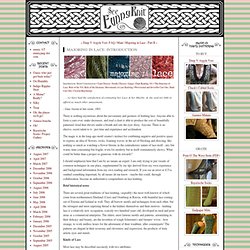
On Designing a Lace Triangle II « Knitting Kninja. Yesterday, I posted about designing a lace triangle using inserts.
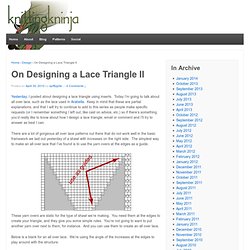
Today I’m going to talk about all over lace, such as the lace used in Arabella. Keep in mind that these are partial explanations, and that I will try to continue to add to this series as people make specific requests (or I remember something I left out, like cast on advice, etc.) so if there’s something you’d really like to know about how I design a lace triangle, email or comment and I’ll try to answer as best I can.
There are a lot of gorgeous all over lace patterns out there that do not work well in the basic framework we laid out yesterday of a shawl with increases on the right side. The simplest way to make an all over lace that I’ve found is to use the yarn overs at the edges as a guide. These yarn overs are static for the type of shawl we’re making. The Home of Mathematical Knitting. The Home of Mathematical Knitting (sarah-marie's mathematical knitting pages and mathematical fiber arts pages) Conference Sessions and Books Carolyn Yackel and sarah-marie belcastro co-organized three mathematics conference sessions, each of which included a sequence of talks and a mathematical fiber arts exhibit.
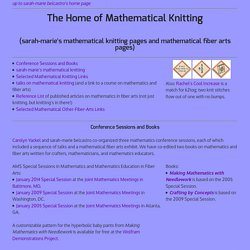
We have co-edited two books on mathematics and fiber arts written for crafters, mathematicians, and mathematics educators. Tessellations using Activity Pattern Blocks. Design a tessellation online (square grid) Totally Tessellated: Welcome. As of July 1, 2013 ThinkQuest has been discontinued.

We would like to thank everyone for being a part of the ThinkQuest global community: Students - For your limitless creativity and innovation, which inspires us all. Knitted Lace Triangle Construction by Michelle Miller. When I started designing knitwear one of the first things that caught my interest was the construction of triangular lace shawls.
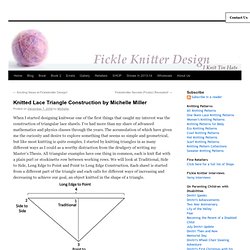
I’ve had more than my share of advanced mathematics and physics classes through the years. The accumulation of which have given me the curiosity and desire to explore something that seems so simple and geometrical, but like most knitting is quite complex. I started by knitting triangles in as many different ways as I could as a worthy distraction from the drudgery of writing my Master’s Thesis. All triangular examples have one thing in common, each is knit flat with a plain purl or stockinette row between working rows. How to create lace motifs. There comes a time in every designer's lifetime when they want to create their own lace.

Whether it's a result of not being able to find the perfect lace repeat in a stitch dictionary or the desire to create something completely unique, you’ll need a way to express these ideas and put them into a useable form. When the urge to create your own motif occurs, you can create a design by sticking to a few simple guidelines. Throughout the process, you’ll test your ideas by swatching in the yarn using the same needles as your final product, making sure to block each swatch the same way the final product is to be blocked. Knitting first, design second. How to insert lace motifs into triangular lace shawls by Michelle Miller.
This article about how to insert lace motifs in triangular lace shawls is the third in a series about designing your own lace knitting.

The first article, How to create lace motifs appeared in Knitty Summer 2009, the second article, Knitted Lace Triangle Construction by Michelle Miller appeared in my blog. Two triangle shawl construction is a common method for knitting lace triangles. The shawl is knit by casting on a handful of stitches, increasing along both edges and on either side of the center stitch. Avoiding ‘the spine’ in a triangular shawl. When making a triangular shawl there are 3 basic constructions: Knit from the point to the top or top to the point.
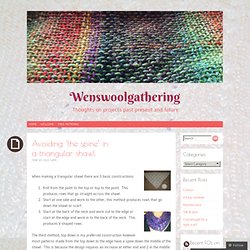
This produces rows that go straight across the shawl.Start at one side and work to the other, this method produces rows that go down the shawl or scarf.Start at the back of the neck and work out to the edge or start at the edge and work in to the back of the neck. This produces V shaped rows. The third method, top down is my preferred construction however most patterns made from the top down to the edge have a spine down the middle of the shawl. This is because the design requires an increase at either end and 2 in the middle of every second row. Introducing Normality. Those of you who know me well (or even casually, I guess) would probably never put "fleegle" and "normality" in the same sentence unless there's a negative conjunction lurking somewhere between the two words. Rest assured--I haven't misplaced my eccentricity, I am just talking about a different normality than, um, normal, that is, the geometric one: normal. normals are lines that run perpendicular to a plane.
Wait! Don't go away! Natural Dyes Home Page. Shaping a PieWedgeShawl. The spiral version will be coded later. From The Knitting Fiend. Crafts - free, easy, homemade craft projects; craft patterns, craft ideas. Easy Button Kid Crafts.
Household. Arts & Crafts. Pearltrees videos. Help. Suburban Scrawl. Knitting.